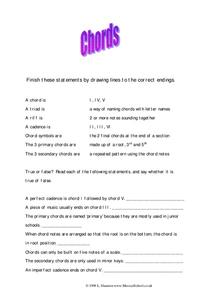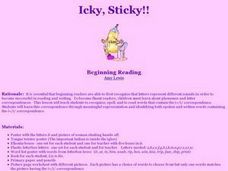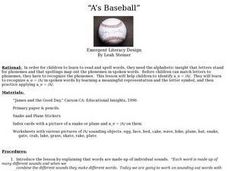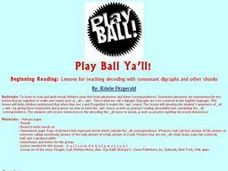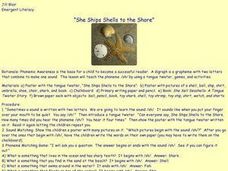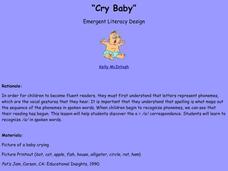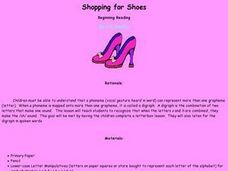Curated OER
The Planets in Our Solar System
Students gain knowledge about earth and space science by studying the nine planets in the solar system as well as their key characteristics. In this solar system instructional activity, students identify the nine planets. Students work...
Curated OER
Chords
In this chords music worksheet, students match 7 terms to their descriptions and respond to 7 fill in the true and false questions.
Curated OER
Vocabulary Building Activity
In this vocabulary learning exercise, students write down 5 vocabulary words on the lines provided as the teacher reads them out loud. Students unscramble 5 vocabulary words and then write each one in a complete sentence.
Curated OER
Printable "it" Word Family Word Jumble
In this online interactive word families worksheet, students examine 10 words with the "it" sound. Students use the word bank to unscramble 10 sets of letters to match the terms in the word bank. This worksheet may also be printed for...
Curated OER
Icky-Sticky
Students practice recognizing the connection between phonemes and letters with an emphasis on finding the short vowel /i/ in words. They each receive a Elkonin letterbox and a picture card with icky-sticky gum on it and the letter i.
Curated OER
A's Baseball
First graders distinguish between short vowel a and long vowel a. They are introduced to the vowel-consonant-e pattern that changes short vowel sounds into long vowel sounds. They practice reading words with the vowel-consonant-e pattern.
Curated OER
/o/... I can't stop yawning!
Students investigate the phoneme, a meaningful representation, and the letter symbol for /o/ (short o). This lesson helps students recognize the /o/ in spoken words and begin to spell words with the assistance of letter boxes. Students...
Curated OER
Eddie the Elephant
Learners need to practice sight words to become proficient readers. So it is very important for children to learn common correspondences. The phoneme for the letter "e" is practiced in this lesson plan.
Curated OER
Spotting Hidden Vowels
First graders recognize the short vowel i in written and spoken language. Through listening activities, they discriminate the vowel sound /i/ from other phonemes. Students associate the phoneme with its letter representation and identify...
Curated OER
I Think I Can
Students identify the digraph /ch/ in written and spoken language. Students practice the production of the /ch/ sound through tongue twister. They identify the initial and final placement of the digraph /ch/ by reading a story to a partner.
Curated OER
Play Ball Ya'll!
Students explore the /awl/ phoneme. They examine the /awl/ sound and how to make the sound themselves. They say /awl/ tongue twisters and use letterboxes to write several 'all' words. They read stories with the /awl/ sound.
Curated OER
Icky Sticky Tin Man
Students recognize the short vowel i in written and spoken language. Through listening and matching activities, they discriminate the vowel sound /i/ from other phonemes. Students associate the phoneme with its letter representation and...
Curated OER
She Ships Shells to the Shore
First graders identify the digraph /sh/ in written and spoken language. After a brief discussion the independent and combined sounds of the phonemes /s/ and /h/ students practice identifying initial and final placement of the new digraph...
Curated OER
Cry Baby
Students recognize the short vowel a in written and spoken language. Through matching and listening activities, they discriminate the vowel sound /a/ from other phonemes. Students associate the phoneme with its letter representation...
Curated OER
Ew!!! It's Icky Sticky!
Students engage in an emergent literacy lesson plan that focuses upon the skill of phonemic awareness. The phoneme sound for the letter "i" is used with a tongue twister to build this important reading skill.
Curated OER
Chicka, Chicka, Choo, Choo
Students begin to read and spell words vis phonemes and letter correspondences. They encounter the concept digraph. This lesson helps the students see a c and h together, they make the ch sound. So, that the students recognize this...
Curated OER
Uhh I don't know!
Students engage in an emergent literacy lesson in order to work on the skill of phonem ic awareness. The use of flashcards is essential for the instruction of the lesson. Students match the card with its beginning phoneme.
Curated OER
Aaaa! The Baby is Crying!
Learners discover the correlation between graphemes and phonemes. They distinguish phonemes in verbal word contexts and match the letters to the phonemes. They focus on working to recognize the phoneme /a/ in its oral and written form.
Curated OER
Shopping for Shoes
Students recognize that when the letters /s/ and /h/ are combined, they make the /sh/ sound. They listen for digraphs in spoken words. They practive writing the letter that makes the /sh/ sound on primary paper. They complete a worksheet...
Curated OER
Shhhhh
First graders identify the digraph /sh/ in written and spoken language. After a brief discussion of the independent and combined sounds of the phonemes /s/ and /h/ students practice identifying initial and final placement of the new...
Curated OER
I Dunno!
Learners explore the sounds of letters in the alphabet. Using phonetic activities, they practice the /u/ sound. Students say tongue twisters. they match pictures to the /u/ sound.
Curated OER
Icky Sticky!!!!
Students recognize the short vowel i in written and spoken language. Through matching activities, they discriminate the short vowel /i/ from other vowel sounds. Students associate the phoneme with its letter representation and identify...
Curated OER
Spelling and Thinking/ Short a
Students participate in a lesson that is concerned with the usage of spelling words that has the short "a" sound. They read the words in list form. Students also write the words in the "an" and "ad" word families.
Curated OER
Making a Grocery List
Students explore vocabulary words related to groceries. Students examine words that can be used immediately, in every day life, particularly in the grocery store. They demonstrate the sounds of letters. Students match labels and sentences.

